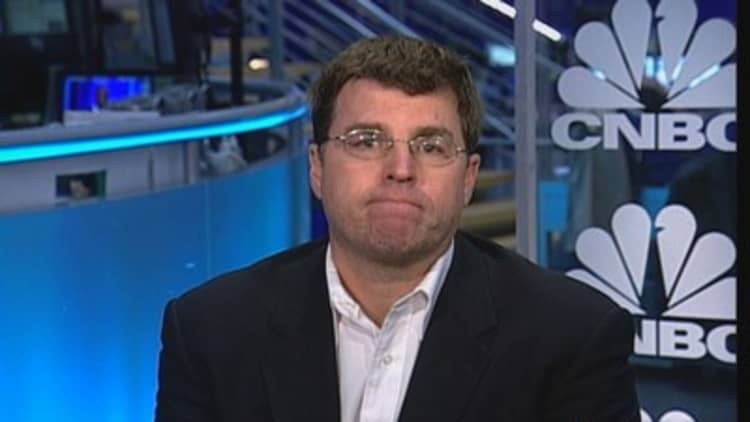
If Obamacare data were a horse race, Kentucky would be leading the pack.
Kentucky has released in-depth, demographically detailed information about enrollments in its state-run Obamacare marketplace, setting a high bar for federal authorities to beat when they finally release their own enrollment data from HealthCare.gov later this week for the first time.
And the Bluegrass State's data show that people who are enrolling in private Obamacare insurance plans there are often young women with more expensive tastes in insurance than might have been expected. But at the same time, the bulk of interest in health-care coverage is, like the rest of the country, coming from the poor and uninsured.
Experts told CNBC.com that they would be surprised if the federal government even matches Kentucky, much less surpasses it, in the level of detail in its enrollment data, given widespread expectations that very few people have actually enrolled in Obamacare insurance through the federal marketplace.
Federal authorities to date have refused to reveal that data since the Oct. 1 launch of the Obamacare marketplaces—even under pressure from Congress—and have not committed to breaking down the enrollment data to the extent Kentucky has.
The Wall Street Journal late Monday, citing two unnamed sources, said the federal government's marketplace has enrolled fewer than 50,000 people in private insurance since October, well below its initial target of 500,000 for just the month of October.
Kentucky's Kynect health insurance exchange has been cited as one of Obamacare's few bright spots for its apparently smoothness of operation, while the federal HealthCare.gov site has been a technological train wreck.
Because of those tech troubles, and the fact that it is handling enrollment for 36 states, HealthCare.gov likely "won't be able to parse the numbers" like Kentucky has, said James Brasfield, professor of management and health services for the Walker School of Business & Technology at Webster University, and author of the 2011 book "Health Policy: The Decade Ahead."
(Read more: One man's loooooooooooooooooong Obamacare odyssey)

In data released by Kynect, it was revealed that a surprising 41 percent of enrollees were under the age of 35; that 59 percent were women compared to just 41 percent men; and that the highest-priced "platinum" plans were the second-most popular coverage option after the mid-priced "silver" plans. The cheapest, "bronze" plans, were the least popular, with just 12 percent opting for them.
Kentucky also has seen something that has been a trend nationally: most enrollees so far in new health coverage offered by Kynect are going to receive Medicaid coverage, not private insurance sold by companies through the exchange.
Kentucky's exchange had enrolled a total of 40,572 people in new health coverage as of last Friday morning, with 33,561 of them enrolled in Medicaid, the joint federal-state insurance program for the poor. A total of 7,011 had enrolled in privately sold insurance through Kynect.
Kentucky's relatively high percentage of enrollees under the age of 35 "will make the insurance companies happy," said Brasfield.
He noted that there had been speculation that not enough younger adults would enroll in Obamacare insurance plans, which could make them more expensive in the long run because young people use less health benefits as a rule than older people.
(Read more: Long way to go to fixing HealthCare.gov)
But "it may be there are a lot of 20-year-olds who did want insurance," Brasfield said.
He wasn't surprised to hear that women were enrolling at a significantly higher rate than men.
"I think women are more likely to be users of health care, and women have children, single women with children, who may be concerned [with] making sure their kids have health care," said Brasfield. "Let's face it, for a lot of things women are more conscientious than men ... a lot of men may go two or three years and not go to the doctor."
Drexel University professor Robert Field said it "surprised me" that the high-premium, low-deductible "platinum" plans were the second-most popular option on Kentucky's Obamacare exchange, with 30 percent of enrollees selecting those highest-priced packages. Silver plans, which are the second-cheapest offering, were the most popular, with nearly 39 percent of enrollment, while gold plans, which are the next level up in price, had 17 percent enrollment.
"Most people don't need coverage that expensive," said Field, author of the new book "Mother of Invention: How the Government Created 'Free-Market' Health Care."
"There's a limited number of people who will come out that much better from buying the platinum plan."
(Read more: Cancer patient: I'm losing my insurance!)
Field noted that even less-than-healthy enrollees might be better off choosing cheaper plans than the platinum versions because the out-of-pocket maximums are the same for every tier of coverage offered on Obamacare exchanges: $6,350 for individuals, and $12,700 for a family.
Those maximums are not that much higher than the $5,000 or more deductibles that some bronze or silver plans have, plans which can cost significantly less in premiums than platinum or gold plans.
Field said the federal government would be wise to disclose as much data about its own enrollment levels as possible this week.
"Because so much distrust is building up, and so much uncertainty, I think it's important for people to get a clear picture of what is happening," he said.
"I think keeping things secret is always the precondition for a public relations disaster," Field said. "It just gives your opponent much for latitude for sowing doubts."
(Read more: Retired executive: I can keep my health-care plan? Not true!)
"If the figures are released and look bad, you can try to contain the damage, you can try to spin it in your direction," he said.
Federal officials, while conceding that initial enrollment data are likely to be low because of HealthCare.gov's problems, have repeatedly noted that the open enrollment period for Obamacare insurance continues until March 31.
(Read more: Insurance cancelled? Don't panic)
The government originally estimated that up to 7 million people nationwide would enroll in private insurance sold through HealthCare.gov, and the 15 other health exchanges being run by individual states and the District of Columbia.
—By CNBC's Dan Mangan, with additional reporting by Jodi Gralnick. Follow him on Twitter @_DanMangan.


